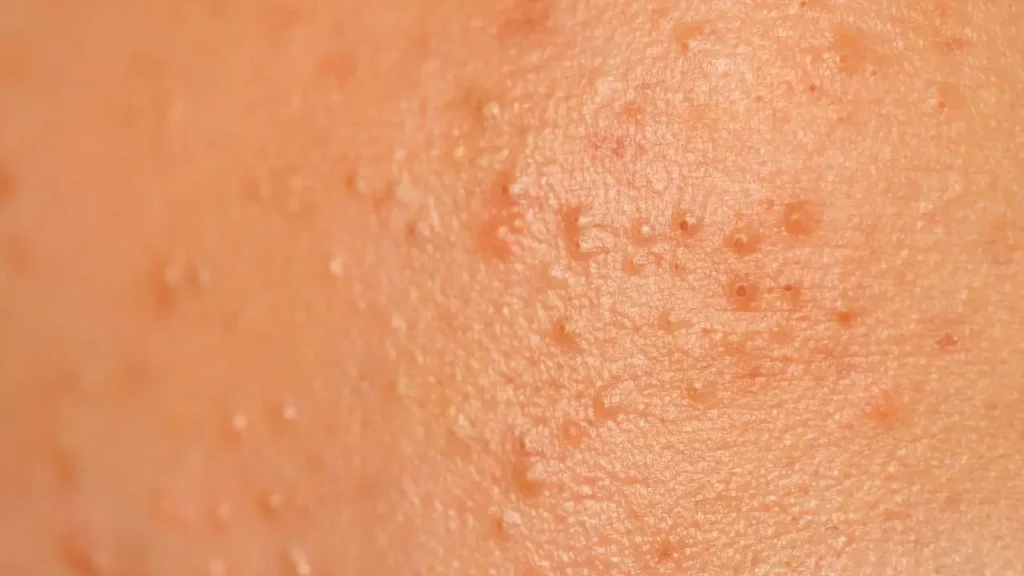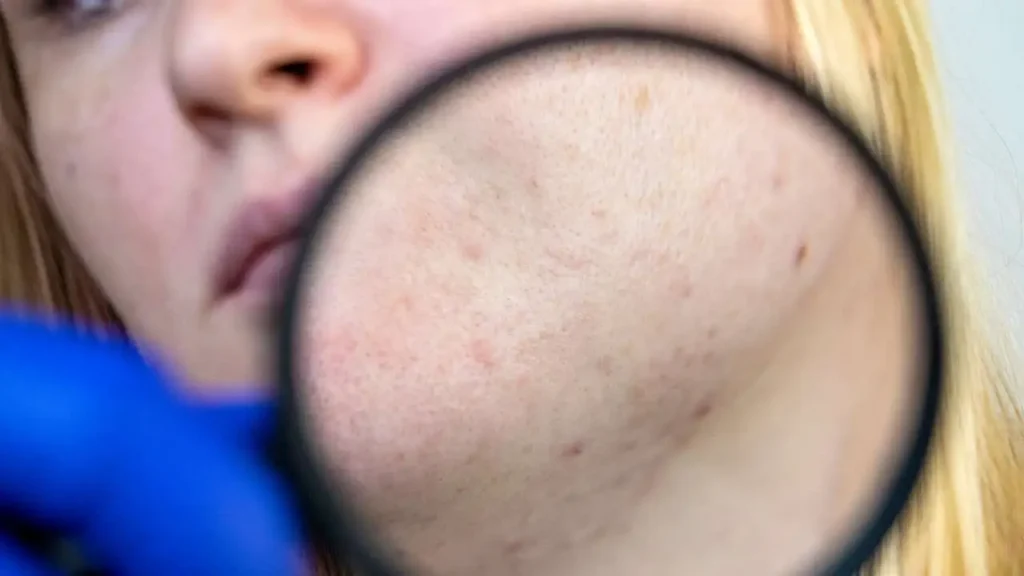Comedonal acne, commonly known as comedones, can be frustrating to deal with, especially because it doesn’t manifest in the classic red and inflamed pimples that most people associate with acne. If you’re tired of dealing with persistent blackheads and whiteheads that never seem to go away, you’re not alone. Understanding what causes comedones and how to treat them can make all the difference in achieving clearer, smoother skin.
In this guide, we will explore everything about comedonal acne, including its causes, effects on the skin, and the best treatments available. If you suffer from mild blackheads or more severe comedones, this article will provide practical solutions to help you regain control over your skin.
What Are Comedones?
Comedones are a form of acne that develops when pores become clogged with oil (sebum), dead skin cells, and sometimes bacteria. Unlike inflamed acne lesions (like papules and pustules), comedones don’t typically cause redness or swelling. Instead, they manifest as small bumps on the skin that can either be open or closed.
- Blackheads (Open Comedones): These occur when a pore is partially blocked, and the trapped sebum oxidizes due to exposure to air, turning black.
- Whiteheads (Closed Comedones): These develop when a pore is completely blocked, trapping sebum and dead skin cells beneath the surface. Whiteheads remain closed and do not oxidize, retaining their white appearance.
Types of Comedonal Acne
There are different forms of comedonal acne, each with its characteristics:
Blackheads
Blackheads are perhaps the most recognizable form of comedonal acne. They appear as tiny, dark spots on the skin’s surface, typically around the nose, forehead, and chin.
- Characteristics of Blackheads:
- Open pores filled with sebum and dead skin.
- Dark coloration caused by oxidation.
- Common in areas with higher oil production.
Whiteheads
Whiteheads are small, white bumps that remain closed under the skin’s surface. Unlike blackheads, they don’t darken because the trapped debris is not exposed to air.
- Characteristics of Whiteheads:
- Closed pores filled with sebum.
- Whitish appearance due to being enclosed.
- Often more stubborn to treat than blackheads.
Microcomedones
These are even smaller versions of whiteheads or blackheads. Microcomedones are not easily visible to the naked eye but can develop into larger comedones over time if left untreated.
Solar Comedones
These are a less common type, primarily caused by prolonged sun exposure. Over time, UV rays can damage the skin, leading to comedonal acne, especially in older individuals. Solar comedones often appear on areas frequently exposed to the sun, such as the cheeks and around the eyes.

What Causes Comedones?
Understanding what causes comedonal acne is the first step toward preventing and managing it effectively. Here are the most common factors contributing to the development of comedones:
Excess Oil (Sebum) Production
Sebum is an oily substance produced by sebaceous glands to moisturize and protect the skin. However, excessive sebum production can lead to clogged pores, resulting in comedones.
- Why It Happens: Hormonal imbalances, particularly during puberty or pregnancy, can increase sebum production. Genetics can also play a role in how much oil your skin produces.
- Areas Affected: T-zone (forehead, nose, chin) and areas with higher oil gland activity.
Dead Skin Cell Buildup
The skin naturally sheds dead cells, but when they aren’t efficiently removed, they can mix with sebum and clog pores. People with comedonal acne may experience slower cell turnover rates, causing more dead skin to accumulate on the skin’s surface.
Makeup and Skincare Products
Certain skincare and makeup products can clog pores if they are too heavy or occlusive. These are often called “comedogenic” products, meaning they have the potential to form comedones.
- Comedogenic Ingredients: Mineral oil, lanolin, and certain forms of alcohol can cause pore blockages.
- Solution: Opt for non-comedogenic products, which are specially formulated to prevent clogging of pores.
Hormonal Changes
Hormonal fluctuations, particularly increases in androgens (male hormones), stimulate the sebaceous glands to produce more oil. This explains why many people experience comedonal acne during puberty, pregnancy, and menstruation.
Diet
While the link between diet and acne is still debated, research suggests that high-glycemic foods (like white bread, sugary snacks, and dairy products) can exacerbate acne by raising insulin levels, which may stimulate oil production.
- Foods to Watch Out For:
- Processed carbs.
- Dairy, especially milk.
- Sugary foods and drinks.
Genetics
If you have a family history of acne, you may be more prone to developing comedones. Genetics can influence how your skin reacts to hormones and how much oil your skin produces.
Stress
Stress doesn’t directly cause acne, but it can worsen existing conditions by triggering hormone production that increases oil output. This creates the perfect environment for comedones to form.
Environmental Factors
- Pollution: Particulate matter and dirt in polluted air can clog pores.
- Humidity: High humidity environments cause the skin to produce more oil, which can lead to comedones.
Effects of Comedonal Acne on the Skin
Comedonal acne doesn’t cause the same level of discomfort as inflamed acne, but it can have lasting effects on the skin’s appearance and texture.
Rough and Uneven Skin Texture
The accumulation of clogged pores results in bumpy skin, especially on the forehead, nose, and chin. While the bumps are often small, they give the skin an uneven texture.
Enlarged Pores
Over time, clogged pores can stretch the skin, making pores appear larger. This effect is particularly noticeable on the nose and cheeks.
Hyperpigmentation
Although comedones are not usually inflammatory, picking or squeezing them can lead to dark spots or post-inflammatory hyperpigmentation, making the skin appear uneven.
Scarring
In severe cases, especially when picking is involved, comedonal acne can cause scarring. These scars are usually small and shallow but can add up over time, leading to an uneven complexion.
How to Treat Comedonal Acne: A Comprehensive Guide
Effective treatment for comedonal acne involves targeting clogged pores, reducing oil production, and promoting cell turnover. Treatments range from over-the-counter products to professional procedures. Here’s a breakdown of the best ways to treat comedones.
Skincare Routine for Comedonal Acne
Your daily skincare routine is key to managing comedonal acne. Using the right products can make a significant difference.
Cleanser
Choose a gentle, non-comedogenic cleanser to remove excess oil, dirt, and dead skin cells without stripping the skin of its natural moisture.
- Recommended Ingredients: Salicylic acid, benzoyl peroxide, or alpha hydroxy acids (AHAs).
Exfoliation
Regular exfoliation helps slough off dead skin cells that could otherwise clog pores. Use a chemical exfoliant, such as a beta hydroxy acid (BHA), to penetrate the pores and remove excess oil.
- Exfoliating Acids for Comedonal Acne:
- Salicylic Acid (BHA): This oil-soluble acid penetrates deep into pores to clear out sebum and dead skin cells.
- Glycolic Acid (AHA): Glycolic acid removes surface-level dead skin cells, helping to refine texture.
Retinoids
Retinoids (Vitamin A derivatives) are highly effective for treating comedonal acne by speeding up cell turnover and preventing the formation of new comedones.
- Over-the-counter options: Retinol, Adapalene.
- Prescription options: Tretinoin, Differin.
Moisturizer
Even if you have oily skin, moisturizing is essential. Use a lightweight, oil-free, non-comedogenic moisturizer to hydrate your skin without clogging pores.
Sunscreen
Daily use of sunscreen is crucial, especially when using exfoliants or retinoids, which make the skin more sensitive to the sun.
- Best Sunscreens for Comedonal Acne: Look for non-comedogenic, oil-free formulas with broad-spectrum SPF 30 or higher.
Over-the-Counter Treatments
- Benzoyl Peroxide: This antimicrobial ingredient helps kill bacteria that could worsen acne, although comedones are not always associated with bacterial infection.
- Salicylic Acid: This beta hydroxy acid penetrates the pores and helps to remove sebum, preventing blackheads and whiteheads from forming.
- AHAs (Alpha Hydroxy Acids): AHAs like glycolic and lactic acids work on the surface of the skin to clear dead skin cells.
Prescription Medications
For more persistent comedonal acne, a dermatologist might prescribe stronger medications.
Topical Retinoids
Prescription-strength retinoids like tretinoin and adapalene help normalize skin cell turnover and prevent clogged pores.
Oral Medications
- Oral Retinoids (Isotretinoin): In severe cases of comedonal acne, isotretinoin may be prescribed to reduce sebum production dramatically.
- Oral Contraceptives: For women, birth control pills that balance hormones can help reduce oil production and prevent comedones.
Professional Treatments for Comedonal Acne
If home treatments aren’t giving you the results you need, professional treatments can be highly effective at clearing out comedones and preventing new ones from forming.
Chemical Peels
A chemical peel involves applying a solution (usually containing AHAs or BHAs) to the skin to exfoliate the outer layers, improving the appearance of clogged pores and uneven texture.
- Best for: Mild to moderate comedonal acne.
- Frequency: Every 4-6 weeks, depending on skin type and severity.
Microdermabrasion
Microdermabrasion is a non-invasive treatment that exfoliates the skin using tiny crystals to remove dead cells and unclog pores. It’s excellent for refining skin texture and minimizing comedones.
Comedone Extraction
In-office comedone extraction involves manually removing blackheads and whiteheads using specialized tools. This treatment provides immediate results but should only be performed by a professional to avoid scarring.
Preventing Comedonal Acne
While it might not be possible to prevent comedones entirely, certain steps can significantly reduce the likelihood of them forming.
Maintain a Consistent Skincare Routine
A regular skincare routine with the right ingredients (exfoliants, retinoids, etc.) can help prevent the buildup of oil and dead skin cells that lead to comedones.
Use Non-Comedogenic Products
Always opt for non-comedogenic skincare and makeup products that won’t clog your pores.
Limit Sun Exposure
Excessive sun exposure can thicken the outer layer of skin, leading to more clogged pores. Use sunscreen daily to protect your skin from UV damage.
Avoid Picking or Squeezing
Though it may be tempting to squeeze comedones, this can cause scarring, hyperpigmentation, and further acne breakouts. Leave extractions to a professional.
Conclusion
Comedonal acne can be a persistent and frustrating condition, but with the right knowledge and approach, it’s entirely manageable. By understanding the causes, effects, and available treatments, you can take control of your skin’s health. A combination of a solid skincare routine, the right products, and professional treatments can help you keep comedones at bay and achieve smoother, clearer skin. Remember, consistency is key when treating comedonal acne, so stick to your routine and give treatments time to work.


